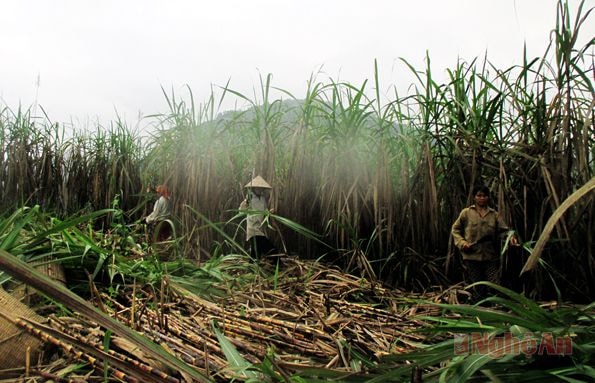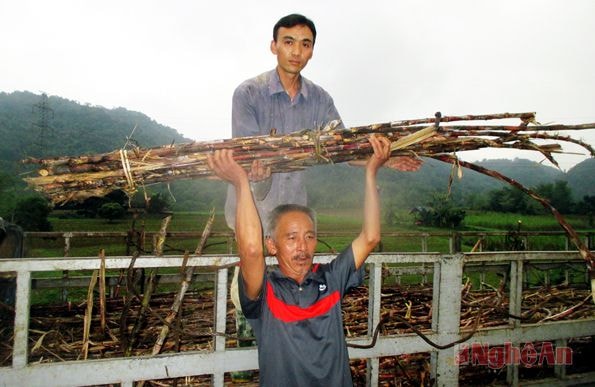Tung Coong Valley
(Baonghean) - People in neighboring villages call the valley in Chi Khe commune (Con Cuong) Tung Coong or Thung Coong. The land is about 200 hectares wide, surrounded by high mountains and dozens of small huts of the villagers growing sugarcane, raising cows and chickens. Nearly 40 years ago, people began to exploit this valley. 15 years ago, Song Lam Sugar Factory developed the raw material area of sugarcane, the main crop of the whole region.
I still remember that day, people were very excited about sugarcane. The villagers were used to growing sugarcane in their gardens, each house had a few clumps, but they were for eating and tied to the foot of the altar on Tet. For the first time, people here heard that a factory would come to buy it, so they wouldn't have to depend on traders like corn and peanuts. They even opened a road to Tung Coong for trucks to transport sugarcane. It seemed that sugarcane would change this valley. The villagers would become rich. Thinking so, people enthusiastically worked the land to grow sugarcane. Some families had only a few acres, while others had a few hectares. It was also the first time that land-clearing machines had come to the valley. So sugarcane brought so many "firsts" to Tung Coong valley. At that time, the small valley was always filled with the sound of plows and excavators clearing the road. Wherever the road was opened, people's hearts were filled with joy. In just a few months, a barren land that used to only grow corn and peanuts, with low productivity and prices, suddenly became a sugarcane raw material area. The valley is filled with green hope.
 |
| The sugarcane fields have only a few people cutting down sugarcane. |
I went to school far away and my job took me to a different pace of life, more hurried, and completely different from this small valley. Over the years, the calluses on my hands gradually faded. I carried with me the memories of the hard-working days, of the bare feet of mountain girls clinging to the mud with heavy baskets on their backs. And the green color of sugarcane in the valley became a beautiful memory. Today, I no longer walk on the familiar steep mountain road from the village into the valley. There is an asphalt road from Highway 7 to Tung Coong. I ride and imagine the green color of sugarcane with excitement. The asphalt road just reached the sugarcane growing area and then cut off. All the crossroads in the valley are still rough dirt roads with big and small rocks. I looked up at the low hills. On the cut sugarcane fields, people are plowing the land to plant the next crop. In addition to sugarcane, the valley now has the green color of acacia and cassava. So this land has other green colors.
I stood looking at the newly planted cassava plot of Mr. Lu Van Huong in Nam Dinh village (Chi Khe - Con Cuong). The young cassava plants were sprouting new leaves. Mr. Huong is just over 50 years old this year, has been on the farm for more than 20 years now, originally from the same village, he called me to visit the hut. Seeing me hesitate in front of the cassava plot, Mr. Huong seemed to understand and immediately said: "Sugarcane is no longer profitable! Many families have switched to growing cassava..." Then he boasted that his family had harvested 2 crops of cassava, each crop earned 27 million. Cash is real rice. The buyer picks up the cassava, weighs it at the farm, and pays immediately. It is more healthy than growing sugarcane. Growing cassava does not require as much care as sugarcane, and the cost of fertilizer and pesticides is less. In terms of immediate benefits, cassava is still better than sugarcane. His family also has another acacia plantation, only nearly 4,000 m2 but last year it also earned more than 30 million.
Near Mr. Huong's field is a sugarcane garden of about half a hectare owned by Mr. Lo Phuong's family. On the field, there are a few people from outside the village who come to help cut sugarcane and get sugarcane tops for the buffaloes and cows. A sugarcane cutter said that in previous years, after Tet, the villagers had not finished planting, so the demand for grass for the buffaloes and cows to plow the fields was still high, and the sugarcane fields were crowded with people coming to cut grass for them. This year, after planting, there are not many people left to find grass for the buffaloes. The labor force has to rely on relatives and inter-family groups. Even though they have decades of experience growing sugarcane, people in Tung Coong are still very passive in terms of human resources, especially when harvesting sugarcane. This year, few people go to get sugarcane tops for the buffaloes, so some families have to cut sugarcane for dozens of days in a row. It was only noon, but the sugarcane fields were already deserted. Only the homeowner and a few relatives stayed to cut sugarcane. A young woman added: "If it goes on like this, it might take a whole week to cut all the sugarcane."
About a 5-minute walk from Mr. Lo Phuong's sugarcane field is Vi Hien's gathering point. I arrived just in time for a sugar factory truck to pick up the sugarcane. The pile of sugarcane gathered was estimated to be just over 5 tons, but it took nearly a dozen people to load it onto the car. Over 60 years old, Mr. Quang Van Hoa, whose field is more than half a kilometer from Mr. Hien's house, still had to come to help. He explained: "After Tet, the young people in the village go to the South to earn money. Only the old men and women remain, so we have to do such hard work. Almost all sugarcane growers are short of workers." Having worked on sugarcane fields, I completely understand the feelings of sugarcane growers like old farmer Quang Van Hoa. From planting to harvesting takes a whole year. In a whole year, they weed, peel leaves, and spray insecticide. Just like farming, sugarcane growers do not have a free season.
 |
| Mr. Quang Van Hoa loading sugarcane |
During a break, Mr. Luong Van Thanh, a sugarcane grower from the early days of developing the sugarcane raw material area, said: After many years of using only a few sugarcane varieties, the land has now degenerated, the sugarcane is barren, the sugarcane plants are stunted, and productivity has decreased. Meanwhile, the price of sugarcane has continuously decreased in recent years. This sugarcane crop, the ceiling price is more than 800,000 VND per ton, that is for grade 1 sugarcane, while in the whole sugarcane raw material area, there are only a few patches that are grade 1. Some households are classified as low, only 650,000 VND per ton. Meanwhile, pesticides and fertilizers have remained the same price for many years. After deducting labor, fertilizer, pesticides, and the Tet advance payment, some households only have a little left when they receive the sugarcane payment!
The sugar factory’s agricultural officer was present to handle the paperwork for the sugarcane truck to move, and said that after many years of use, the sugarcane variety was gradually degenerating. The sugar factory was cultivating new varieties in Tho Son commune (Anh Son), imported from Thanh Hoa, but it would take at least 2 more years to have new varieties. In any case, this sweet-tasting crop has been in the valley for 15 years and has changed the lives of the people here to some extent. It can be said that this is also a success. Therefore, the people of Tung Coong are very attached to sugarcane…
One thing that has been troubling farmers in the Tung Coong valley for many years is the source of domestic water. The valley, hundreds of hectares wide, has only one small stream at the end of the valley. People have thought of a dam at the main stream of the valley to supply water to households farming and farms in the valley. But they only dare to dream, because such a billion-dollar project is beyond their capacity. "If there is water, this valley will definitely become a village," said Mr. Thoan in a dreamy puff of cigarette smoke... Having said that, he looked out over the endless green of sugarcane, forests, and rocky mountains. That was a rare leisurely moment in the day of the sugarcane growers here!
You Wei






